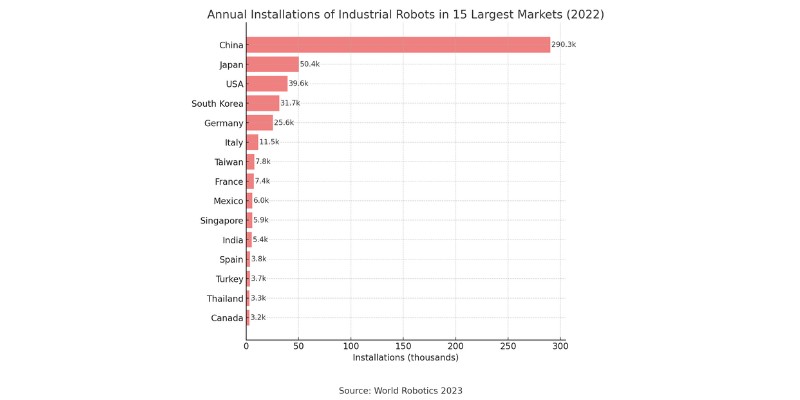创建您的CubeMars账号

中国已成为全球最大的工业机器人市场,这得益于制造业对自动化需求的增长,自动化也成为中国未来经济增长和提升全球竞争力的关键战略。" ——先进自动化协会 (A3) 主席 Jeff Burnstein
在过去十年中,中国的机器人市场经历了前所未有的快速增长,正逐步成为全球自动化领域的领导者。根据国际机器人联合会(IFR)发布的《2023世界机器人报告》,中国在2022年单年安装了近29万台工业机器人,占全球安装量的52%。

过去五年中,中国的机器人安装增长率年均约为25%,远超全球11%的平均增速。这一数据远远超过了日本、韩国和美国等主要市场的机器人安装量。
2024年在北京举行的世界机器人大会进一步凸显了中国在全球机器人领域的影响力。此次大会汇聚了来自20多个国家的600多家展商,展示了推动机器人技术创新的尖端技术、研究和应用,彰显了中国在机器人和人工智能领域的进展和雄心。

中国在机器人领域的领导地位主要源于其推动自动化以提升生产力和保持全球制造业竞争优势的战略。随着劳动力成本的上升,中国公司越来越多地采用机器人,以实现更高的精度、效率和可扩展性。这一趋势在汽车、电子和金属加工等行业尤为明显,这些行业在生产线中引入了大量机器人。
汽车行业:汽车行业一直是中国机器人应用的重要推动力。作为全球最大的汽车市场和生产基地,以及快速扩展的电动汽车领域,汽车制造对自动化的需求巨大。汽车制造商利用机器人进行焊接、喷漆、组装和质量控制,以提高生产效率和降低成本。
电子和半导体行业:自2016年以来,电子和半导体行业已超过汽车行业,成为中国最大的工业机器人消费者。中国在生产电子设备、电池、半导体和微芯片方面处于全球领先地位,这些产品需要高精度的制造过程。机器人在组装、测试和包装等任务中必不可少,使公司能够扩大生产规模,同时保持高质量。
金属加工和通用制造业:金属加工行业,包括机床制造和金属成型,也见证了机器人应用的显著增长。机器人帮助制造商提高产品质量和工人安全,减少浪费,并提升整体生产力。
中国政府通过“中国制造2025”等举措大力推动机器人行业的发展,旨在通过集成先进技术如机器人和人工智能(AI)来现代化制造业。这一战略得到了大量财政支持,包括补贴、税收优惠和研发资金,目标是减少对外国技术的依赖,提升制造业的价值链。
中国的自动化推进与其经济战略相一致。截至2022年,中国的制造业机器人密度达到每万名员工322台,超越了美国的274台。在最近召开的20届中央委员会第三次全体会议上,中国政府重申了机器人作为经济增长关键驱动因素的重点,强调了中国作为全球最大机器人市场的独特地位。
中国的机器人行业经历了显著的转型,从依赖外国技术转变为成为重要的创新者。在过去十年中,中国的机器人公司已经成为全球领导者。他们正在开发覆盖工业自动化、物流、医疗、服务和类人机器人等领域的先进机器人解决方案。这一转变标志着从简单的大规模生产到高科技、集成AI、机器学习、先进传感技术和人机交互的复杂机器人系统的关注。
展望未来,中国在机器人领域的领导地位有望进一步巩固,计划整合AI与机器人技术,创造更智能、适应性强和自主的系统。中国政府将继续大力投资于建立强大的机器人生态系统,包括研发、人才培养、制造和全球出口。